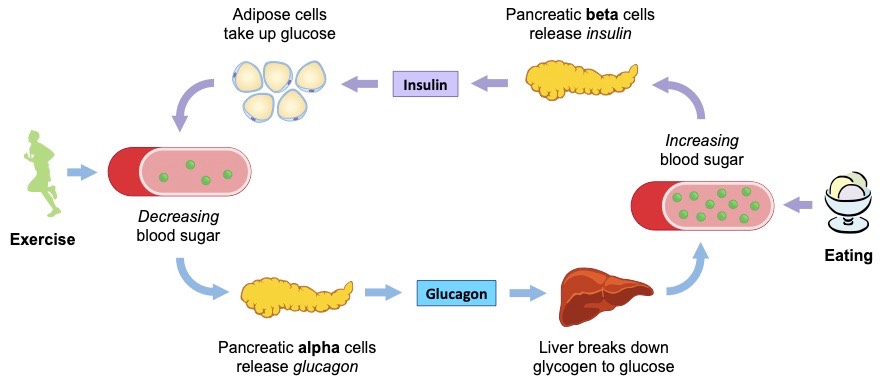Key Knowledge:
|
Maintaining internal equilibrium in animals requires constant physiological adjustments to a variety of parameters, including:
- Body temperature – monitored by thermoreceptors and maintained by the actions of the hormone thyroxin (thyroid gland)
- Blood glucose concentrations – monitored by chemoreceptors and maintained by the hormones insulin and glucagon (pancreas)
- Water balance – monitored by osmoreceptors and maintained by anti-diuretic hormone (ADH) released by the hypothalamus
Body Temperature
Animals capable of maintaining a constant body temperature by regulating their metabolic activity are called homeotherms
- The skin detects external temperature fluctuations (via thermoreceptors) and relays this information to the hypothalamus
- The hypothalalmus acts as a control centre in thermoregulation by responding to fluctuations in internal body temperatures
Thyroxin is a hormone secreted by the thyroid gland in response to signals initially derived from the hypothalamus
- The primary role of thyroxin is to increase the basal metabolic rate (by stimulating carbohydrate and lipid metabolism)
- A consequence of increasing metabolic activity is the production of heat – hence thyroxin helps to control body temperature
- Thyroxin levels within the body will be increased in response to a decrease in body temperature (i.e. negative feedback)
Other mechanisms by which homeotherms may function to heat the body if internal temperatures drop include:
- Vasoconstriction – Skin arterioles constrict to move blood away from the body surface and retain the heat carried within the blood
- Shivering – Muscles begin to shake in small movements, expending energy through metabolic activity (which produces heat)
- Piloerection – Animals with furry coats can make their hair stand on end, trapping pockets of warm air close to the body surface
Additional mechanisms by which homeotherms may function to cool the body if internal temperatures rise include:
- Vasodilation – Skin arterioles dilate to move blood closer to the body surface and allow for heat transfer (i.e. convective cooling)
- Sweating – Sweat is released from exocrine glands, which evaporates at the cost of latent heat in the air (i.e. evaporative cooling)
- Behavioural responses – Animals may physically remove themselves from warm environments in order to cool (e.g. burrowing)

Blood Glucose Levels
The body needs glucose to make ATP (via cell respiration), however the amount required will fluctuate according to demand
- High levels of glucose in the blood can damage cells (creates hypertonicity) and hence glucose levels must be regulated
Two antagonistic hormones are responsible for regulating blood glucose concentrations – insulin and glucagon
- These hormones are released from pancreatic pits (called the islets of Langerhans) and act principally on the liver
When blood glucose levels are high (e.g. after feeding):
- Insulin is released from beta (β) cells of the pancreas and cause a decrease in blood glucose concentration
- This may involve stimulating glycogen synthesis in the liver (glycogenesis), promoting glucose uptake by the liver and adipose tissue, or increasing the rate of glucose breakdown (by increasing cell respiration rates)
When blood glucose levels are low (e.g. after exercise):
- Glucagon is released from alpha (α) cells of the pancreas and cause an increase in blood glucose concentration
- This may involve stimulating glycogen breakdown in the liver (glycogenolysis), promoting glucose release by the liver and adipose tissue, or decreasing the rate of glucose breakdown (by reducing cell respiration rates)

Water Balance
Osmoregulators maintain an internal balance between water and dissolved solute levels, regardless of environmental conditions
- Homeostasis cannot be maintained if water levels drop (dehydration) or are raised (overhydration) without regulation
Water retention in the body is controlled by the kidneys (water can be reabsorbed into the blood from the collecting ducts of nephrons)
- The amount of water reabsorbed from the collecting ducts is controlled by anti-diuretic hormone (ADH)
- ADH is released from the posterior pituitary in response to dehydration (detected by osmoreceptors in the hypothalamus)
- ADH increases the permeability of the collecting duct to water, by upregulating production of aquaporins (water channels)
- This means less water remains in the filtrate, the urine becomes more concentrated and the individual urinates less (i.e. anti-diuresis)
- When an individual is suitably hydrated, ADH levels decrease and less water is reabsorbed (resulting in more dilute urine)
- An easy way to remember that ADH increases water retention is that the hormone is released when you Are DeHydrated
